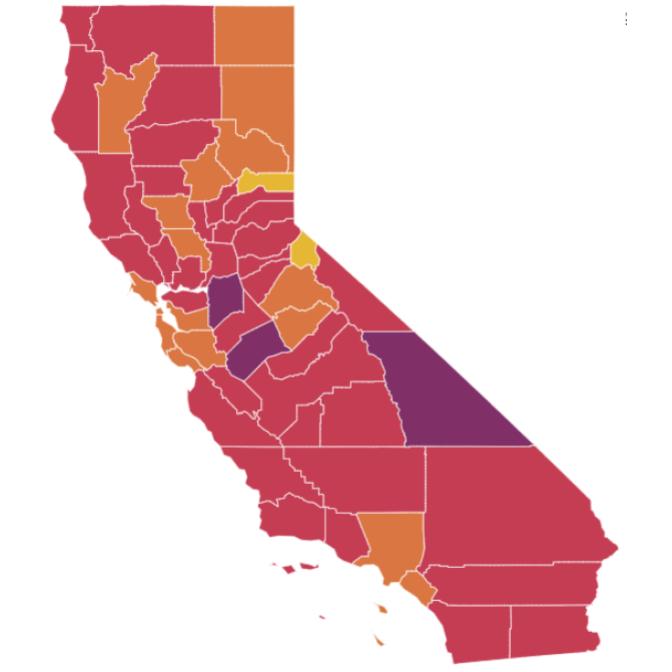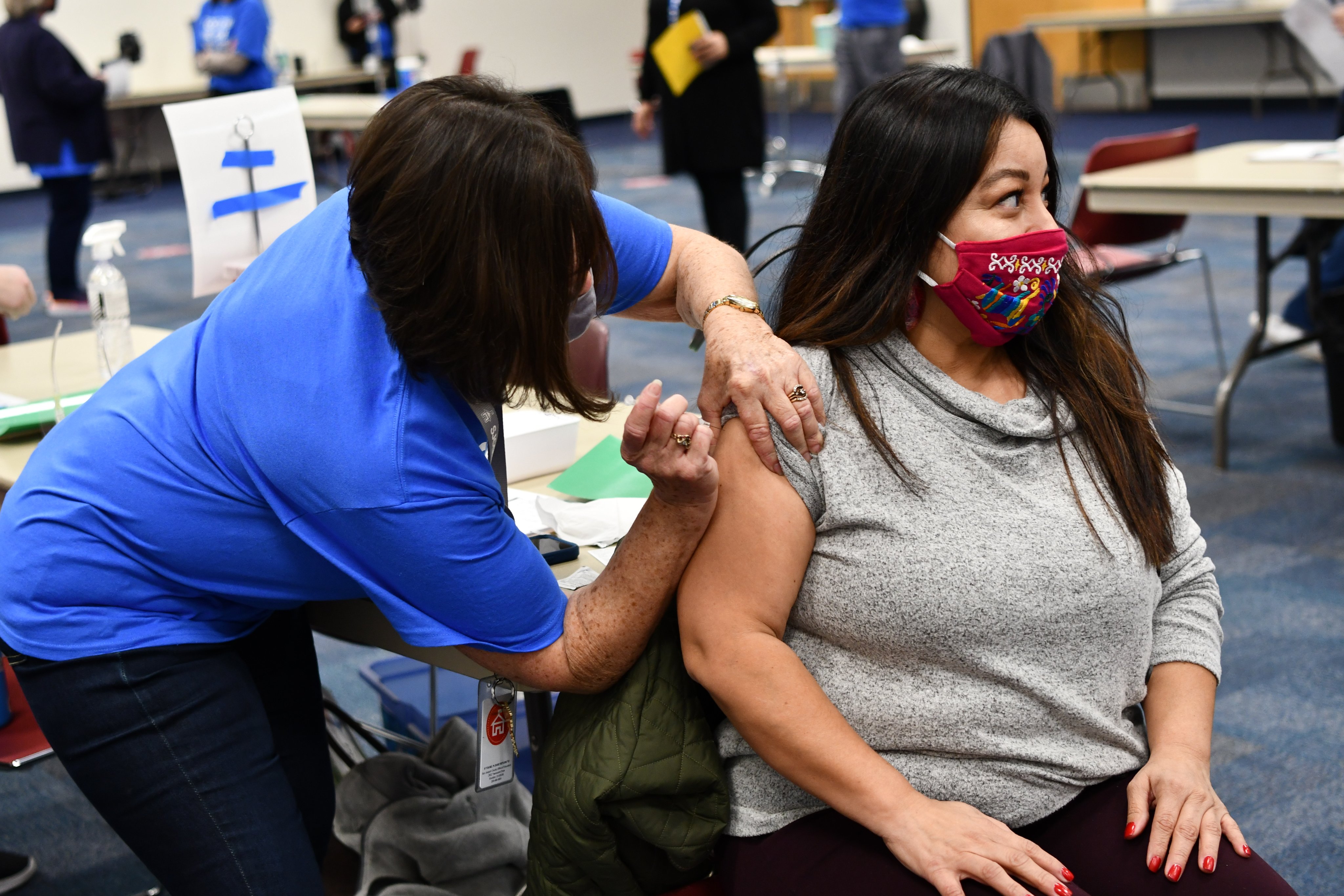Perpetually Purple: Why San Joaquin is Struggling to Move to a Less Restrictive Tier
March 30, 2021 at 8:53 pm

Three California counties are still in the purple tier: San Joaquin, Inyo, and Merced.
covid19.ca.gov
As of Tuesday, San Joaquin County is one of only three counties in the purple tier, the most restrictive level in California’s COVID-19 reopening framework, and has the highest case rate in the state. It will be at least another week until the county reaches the red tier, as it must keep its coronavirus cases under certain thresholds for two weeks before moving. So why is San Joaquin still stuck in the purple tier while the rest of the state reopens?
First, a quick reminder on how the tier system works. A county’s tier is determined by three numbers: its daily case rate per 100,000 people, its test positivity rate, and its health equity metric (the positivity rate for people living in the most socioeconomically disadvantaged neighborhoods). Once all three metrics reach the below criteria for a less restrictive tier for two consecutive weeks, the county can move.

There is also an alternate way to move tiers. If a county’s case rate is currently in the purple, but its health equity and positivity rate are in the orange for two straight weeks, it can move to the red.
Once in the red tier, activities like indoor dining, movie theaters, and gyms are permitted. Retail capacity will double from 25% to 50%, and grocery stores can open to full capacity. However, bars will remain closed.
Up until last week, schools also had to wait until the red tier to return to in-person classes. However, new guidance from the California Department of Public Health (CDPH) states that schools may open for all grades in all tiers as long as the county has a daily case rate of less than 25 per 100,000.
Currently, the four tiers are purple, red, orange, and yellow, with development of an additional green tier underway. But while most of the state is in the red or the orange, San Joaquin is still in the purple.
The simplest answer to why is that the county’s case rate has been consistently too high. This week, San Joaquin recorded a daily case rate of 10.2 per 100,000 people. This is just above the threshold of 10.0 to enter the red tier, a criterion which the state already relaxed from seven per 100,000 people in mid-March due to increased vaccinations.
Additionally, the county’s case rate has plateaued over the past month. After dropping rapidly from the peak of the winter surge, the case rate began stagnating at 11.6 during the first week of March. It then decreased slightly for two weeks before popping back up to 11.7 last week.
However, the current rate of 10.2 per 100,000 is still an improvement in the grand scheme of things; it is the lowest the county has seen since early November, when Gov. Gavin Newsom enacted a stay-at-home order to prevent hospitals from being overwhelmed.
Another reason for San Joaquin’s purple status is that the county is not testing enough. Before assigning tiers, the CDPH adjusts the case rate of each county based on the volume of coronavirus tests it administers. This measure is supposed to incentivize counties to test more; if they do, their case rate used to assign their tier will be lowered by some linear factor.
Conversely, if a county tests less than the state median volume, its case rate will be raised. This has repeatedly happened in San Joaquin.
Out of the 13 weeks of 2021 so far, the case rate has been raised in 11 of them. The county has not tested above the state benchmark since late January.
While this adjustment factor is usually not very large (San Joaquin’s highest this year was 1.067), it has been enough in some weeks to scuttle the county’s chances of moving to the red tier.
Two weeks ago, San Joaquin reported a daily case rate of 9.9 per 100,000. Unadjusted, this number would have been just enough to move to the red. However, the county administered only 277 daily tests per 100,000 people that week, substantially under the state median of 320.5. Its case rate for tier assignment was subsequently raised to 10.5, making it ineligible to move.
More testing also helps decrease San Joaquin’s test positivity rate and health equity metric, the other two numbers used to assign tiers. Under the state’s accelerated criteria for tier movement, a county may move to the red if both those metrics are within the thresholds for the orange, regardless of the case rate.
While San Joaquin’s positivity rate has consistently been in the orange for almost a month, its health equity metric has twice prevented it from qualifying for the red tier. Two weeks ago, it was widely presumed that the county would be transitioning to red based on the accelerated framework. However, the health equity metric shot up from 4.2% to 5.8%, outside of the limit for the orange and preventing a move to red.
Last week, San Joaquin again narrowly missed qualifying for the red tier because its health equity metric was at 5.4%, 0.1 of a percentage point above the threshold for orange.
However, things finally changed this week. San Joaquin County reported 10.2 daily cases per 100,000 people, a positivity rate of 4.4%, and a health equity metric of 4.8% this week. Based on the accelerated framework, the county has earned one week’s credit towards the red. If the current numbers hold for another week, San Joaquin will move to the red tier.
Vaccinations in the county have also been progressing, with eligibility set to open up to everyone 50 and older on Thursday. Roughly 22.7% of residents have received at least one shot, with 12.2% having been fully vaccinated. However, this is well behind the statewide numbers of 30.2% and 14.9% respectively. In terms of shots per capita, San Joaquin is 41st out of 58 California counties, putting it close to the back of the pack.
The county is also experiencing substantially higher COVID-19 numbers than the rest of the state, as California is currently averaging 4.8 daily cases per 100,000 people and a 1.8% positivity rate.
San Joaquin is even further behind in regards to hospitalizations. Right now, California has around 30.3% intensive care unit capacity. On Tuesday, the county reported having its ICUs at 102% capacity, a 43% increase over the past week. However, there were no deaths from COVID-19 on that day.

